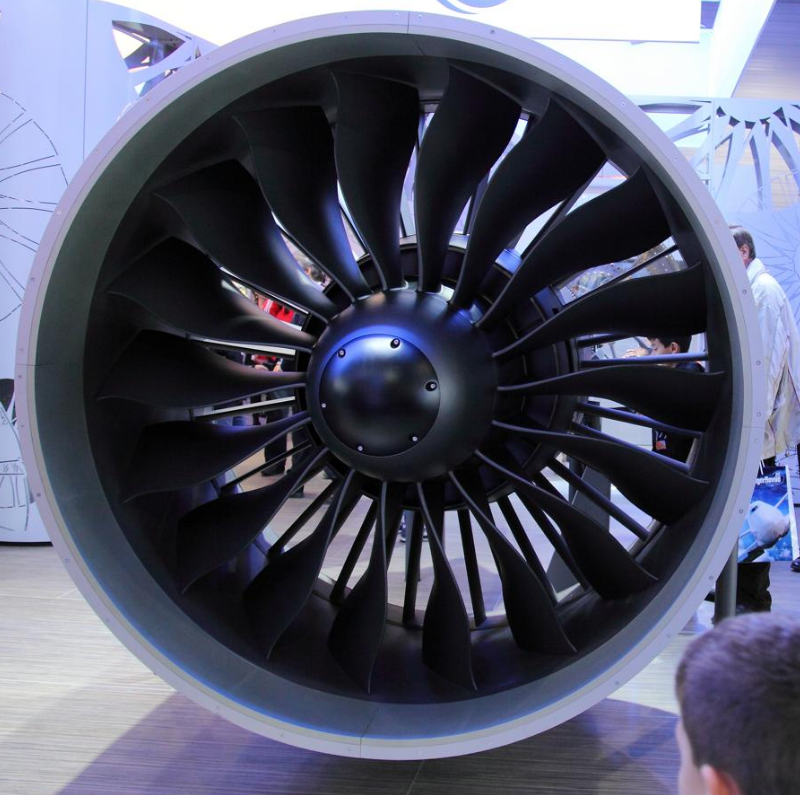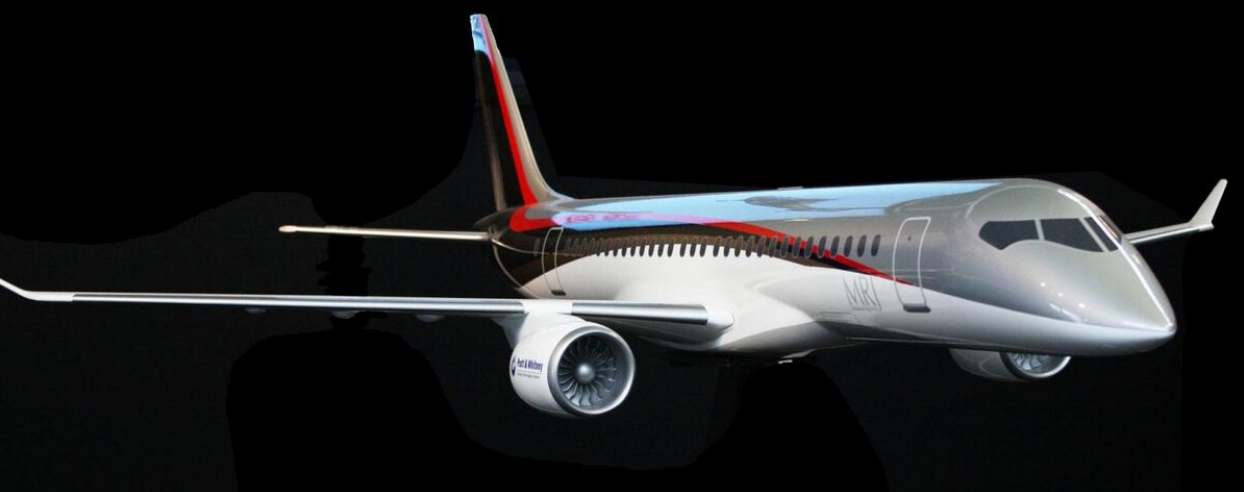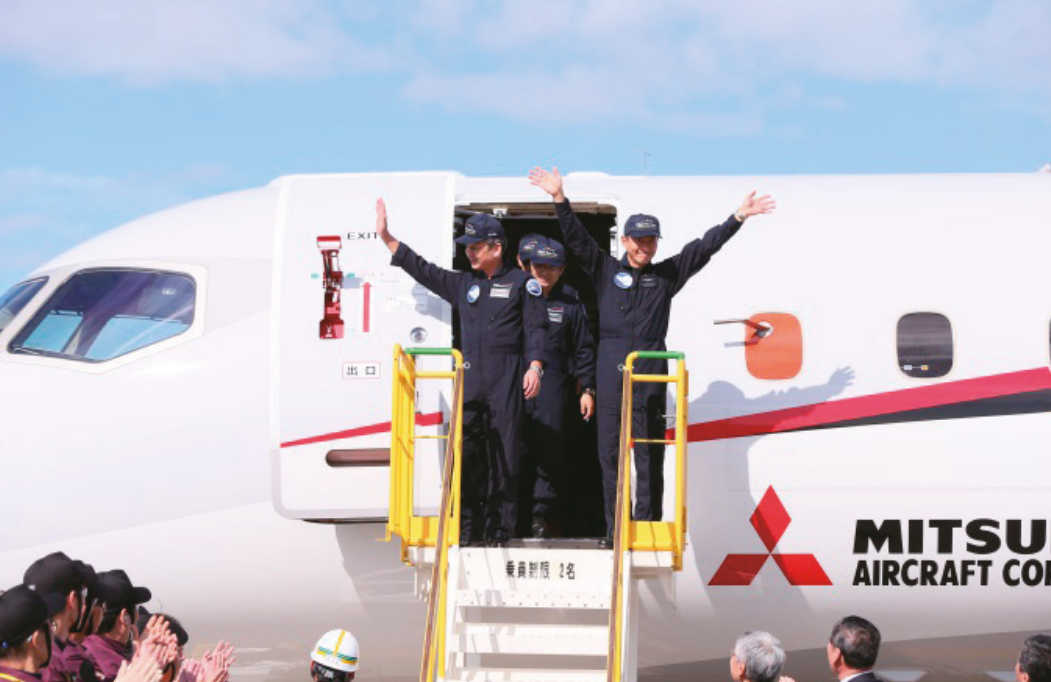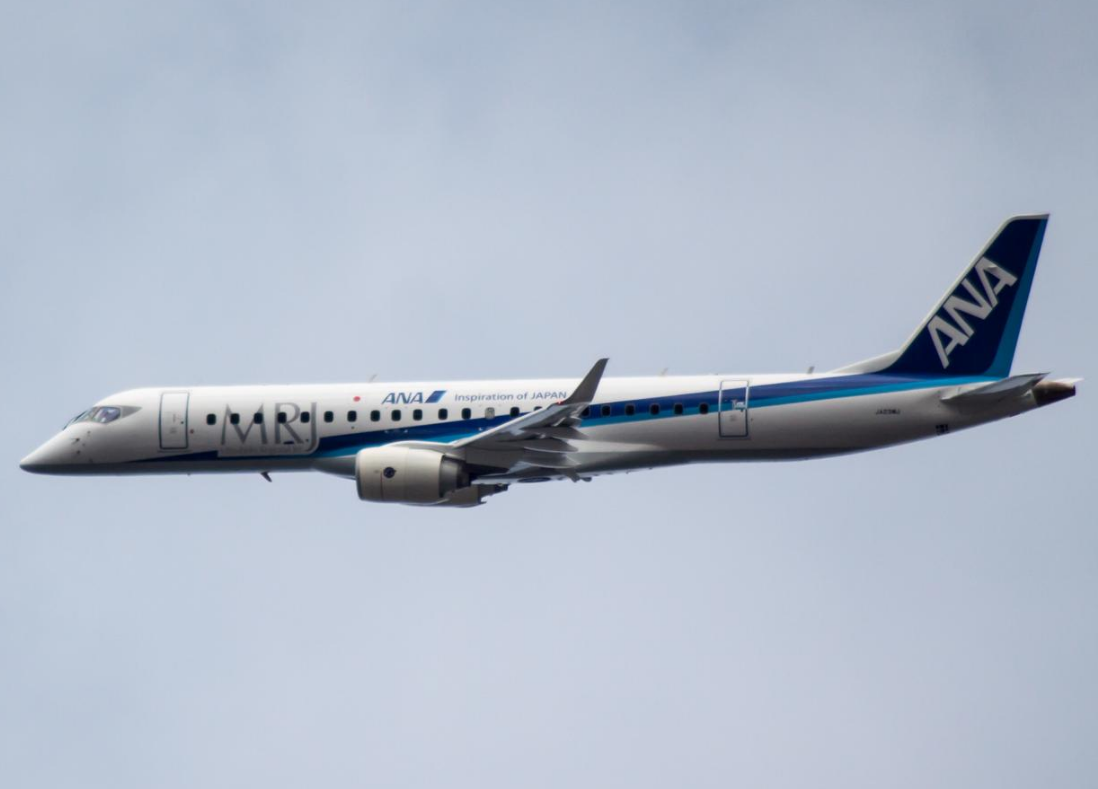The Mitsubishi Regional Jet (Japanese: 三菱リージョナルジェット), or MRJ for short, is a twin-engine regional jet aircraft seating 70–90 passengers manufactured by Mitsubishi Aircraft Corporation, a partnership between majority owner Mitsubishi Heavy Industries and minority owner Toyota Motor Corporation with design assistance from Subaru Corporation, itself already an aerospace manufacturer. The MRJ will be the first airliner designed and produced in Japan since the NAMC YS-11 of the 1960s, which was produced at a loss. The first flight of the MRJ was in November 2015. After several delays, deliveries are now scheduled to start by mid-2020.
- 三菱リージョナルジェット
- regional
- twin-engine
1. Development
1.1. Launch

In 2003 the Japanese government started a five-year, ¥50 billion ($420 million) research program to study an indigenous regional jet for 30 to 90 passengers, led by Mitsubishi Heavy Industries (MHI).[1] In 2004 MHI was focused on a 2m high by 2.8m-wide, four-seat abreast cabin, seating 30 to 50 passengers, and was hoping to fly a prototype in 2007 and deliver the first aircraft in 2010.[2] In 2005 it switched to a larger 70-90 seat category.[3]
MHI launched its concept at the 47th Paris Air Show in June 2007, showing a full-scale cabin mock-up and aiming to be the first regional jet all-composite airframe, with certification targeted for 2012.[4] Mitsubishi formally offered the MRJ to airlines in October 2007 - the first Japanese airliner since the NAMC YS-11 production stopped in 1974 - after being the first airframer to select the Pratt & Whitney PW1000G geared turbofan offering a 12% reduction in thrust specific fuel consumption, rated at 15,000 lbf (67 kN) thrust on the 70- to 80-seat MRJ70 and 17,000 lb thrust (75.7 kN) on the 86- to 96-seat MRJ90, projecting a ¥150 billion ($1275 million) development cost.[5]
MHI officially launched the Mitsubishi Regional Jet Program on March 28, 2008 with an order for 25 aircraft (15 firm, 10 optional) from All Nippon Airways, targeting a 2013 introduction.[6] Mitsubishi is targeting a 20% share of 5,000 sales forecast in the 70-90-seat bracket over 20 years. Flight testing was scheduled for late 2011 and the $1.9-billion programme necessitates 300-400 sales to recoup its cost.[7]
1.2. Design

In September 2009 Mitsubishi unveiled extensive design changes, using aluminium instead of carbon fibre composites for the aircraft's wings and wingbox; the remaining composite parts will make up 10-15% of the airframe: the empennage.[8] The cabin height is increased by 1.5 in (4 cm) to 80.5 in (204 cm) and the fuselage height is increased to 116.5 in (296 cm), giving a rounder cabin, wider and higher than its competition.[8] The program was delayed six months with final design frozen in mid-2010, first flight delayed to the second quarter of 2012 and deliveries to early 2014.[8][9]
As the MRJ90 MTOW of 39.6 t is above the US regional carriers scope clause of 39 t, SkyWest and Trans States Holdings could convert their MRJ90 orders for 100 and 50, respectively, to the 1.4 m shorter MRJ70: 67% of the 223 firm MRJ90 orders. But the MRJ70 seats only 69 in two classes and attain the 76 seats scope close limit only in all-economy: Mitsubishi wants to increase seating within its fuselage to compete with the currently compliant Embraer E-175 and Bombardier CRJ900.[10] Maintenance intervals are 750 flight hours per A Check and 7,500 flight hours per C check.[11]
1.3. Assembly

On 15 September 2010, the Mitsubishi Aircraft Corporation announced that it had entered the production drawing phase and was proceeding with the manufacturing process.[12] Assembly of the first aircraft began in April 2011 with construction of the emergency escape for the cockpit.[13] In April 2012, first flight was delayed to 2013.[14] In December 2012, the MRJ90s delivery was scheduled for 2017.[15]
In early 2013, Pratt & Whitney delayed the PW1200G certification to the "latter half" of 2014, after the MRJ first flight scheduled for late 2013.[15] On 22 August 2013, Mitsubishi announced a third delay to the program, and that the first flight would take place in the second quarter of 2015 instead of end-2013, while the first delivery to launch customer ANA would take place in the second quarter of 2017 instead of 2015, due to parts delivery problems including Pratt & Whitney engines.[16] On 7 September 2013 were exhibited a prototype of the left wing and four aluminium sections : forward fuselage, front mid fuselage, aft mid fuselage and aft fuselage, to be assembled in October 2013.[17] Mitsubishi has hired foreign experts to help with relations with suppliers, ground tests, flight tests, and certification.[18]
Pictures of the first fully assembled MRJ90 were available on 26 June 2014.[19] An official rollout occurred on 18 October 2014.[20]
1.4. Testing

The maiden flight of the MRJ90 took place on 11 November 2015.[21][22] On 24 December 2015, Mitsubishi announced a one-year delay for the first delivery of the MRJ, to mid-2018.[23] The delay was attributed to insufficient wing strength and the redesign of the landing gear for better safety.[24] Much of the flight testing for the MRJ90 will take place in Moses Lake, Washington, due to the crowded airspace in Japan causing scheduling difficulties.[25] Static strength test were completed on November 1, 2016 and confirmed that the airframe could withstand 1.5 times the maximum load.[26]
In January 2017, a further two-year delay was announced, pushing the expected first delivery to mid 2020.[27] This resulted from moving the avionics bay and wiring looms and in March 2017 the flight certification program was extended from 2500 to 3000 flying hours.[28] Mitsubishi didn't confirm. Four of the five delays were caused, at least partly, by failures to document work for certification or similar failures. As a result, development cost ballooned to 350 billion yen (US$3.17 billion) and the project might never able to fully recover its costs.[29] Mitsubishi originally planned to use five flight test aircraft and two ground test aircraft but one or two additional aircraft will also be needed following this introduction of a two-year delay to mid-2020.[30]
Seattle engineering consultants Aerotec L.L.C. saw problems for avionics and its wiring certification: damage could cause single point of failure, due to fire, water flooding from a ruptured waterline or from part penetration of an engine explosion. This necessitated hardware changes in the bays, now frozen, but the electrical wiring interconnection system have to be reconfigured with hired specialist Latecoere. In June 2017, 940 hours of flight tests have been done and the four prototypes have an above 98% availability.[31] On 21 August, FTA-2 experienced a flameout 170 km (92 nmi) west of Portland International where it landed, partial damage was confirmed in the PW1200G and the test fleet was grounded until the cause is known.[32] Flight testing resumed on 6 September.[33]
By December 2017, the MRJ test campaign was half done with 1,500 flight hours and less than 1% cancelled due to technical issues. Their rate is accelerating with tests set up before the January 2017 avionics bay redesign: special runway tests, extreme environment and high altitude tests, to be completed in 2018. An additional flight test aircraft incorporating the redesign will join the campaign in the second half of 2018, focused on wiring tests like lightning and high-intensity radio-frequency.[34] Two additional aircraft (10007 and 10010), recently painted white and under structural assembly in December, will be completed and will join the flight test campaign towards the end of 2018.[35] At the end of 2017, the mid-2020 deadline seemed difficult to achieve.[36]
In January 2018, the avionics bay rearrangement and rerouted wiring were almost complete to be adequate for extreme events such as bomb explosions or water ingress underfloor.[37] Upgrades and ground tests were performed on four flight test aircraft from February to March 2018 at Moses Lake, preceding flight testing for natural icing, avionics and autopilot, performance, stability and control.[38]
In April 2018, the test fleet had logged 1,900 flight hours.[39] The flight-test fleet attained 2,000 hours in May 2018, and as most of the flight envelope was explored, the next trimester shifted to runway performance: takeoff, landing and minimum control speeds.[40] The MRJ70 test aircraft (number 8 and 9) were in final assembly as of May for expected delivery by the end of 2021, one year after the MRJ90 introduction.[10] An MRJ in All Nippon Airways livery was exhibited at the 2018 Farnborough Airshow, alongside appearances by the similar Embraer 190 E2 and larger Airbus A220.[41] In October, Bombardier sued Mitsubishi in Seattle, alleging that its ex-employees stole trade secrets to help for US certification.[42]
1.5. Production

A new production facility for the aircraft will be built at Komaki Airport in Nagoya, Japan , on land purchased from the government at a total cost of 60 billion yen. Production at this plant is expected to commence in fiscal year 2016, with the new plant producing 10 aircraft per month and employing 2,000 workers.[43] Mitsubishi announced in June 2013 that it would establish a quality control facility in Illinois for the sourcing of MRJ components from the United States.[44]
MHI employs new production methods such as integral wing stringers, unusually tight tolerances, shot peening of curved surfaces, and vacuum assisted resin transfer molding, intended to increase quality and thus reduce expensive fault correction to keep price competitive.[45]
On 26 April 2017, the fifth MRJ was complete in ANA livery, lacking only engines and nose cone, aircraft number six and seven had their fuselage and wings joined without the tails and the eighth, the first MRJ70, was at the assembly line start; Mitsubishi can manufacture 12 aircraft concurrently: in station one are joined fuselage sections, in station two the landing gear, wings and horizontal stabilisers are attached, in section three the major components are assembled, in outfitting takes place in section four and ground tests in station five, then the completed aircraft moves to painting.[30]
1.6. Stretch
A 100-seat stretched MRJ100 was studied in March 2011.[46] (As of June 2015) it was still under evaluation.[47]
2. Specifications

| Variant | MRJ70 | MRJ90 |
|---|---|---|
| Passengers | 69 (9J + 60Y) to 80 | 81 (9J + 72Y) to 92 |
| Seat pitch | 74–79 cm (29–31 in) in Y, 91 cm (36 in) in J | |
| Cabin | 2.03 m / 6 ft 8in Height × 2.76 m / 9 ft 1in Width | |
| Length | 33.4m / 109 ft 8in | 35.8m / 117 ft 5in |
| Wing span | 29.2m / 95 ft 10in | |
| Tail height | 10.4m / 34 ft 2in | |
| Max takeoff weight | LR : 40,200 kg (88,626 lb) | LR : 42,800 kg (94,358 lb) |
| Max landing weight | 36,200 kg (79,807 lb) | 38,000 kg (83,776 lb) |
| Max zero fuel weight | 34,000 kg (74,957 lb) | 36,150 kg (79,697 lb) |
| Operating empty weight | - | 26,000 kg (57,320 lb)[49] |
| Fuel Capacity | - | 12,100 L (3,200 US gal)[50] |
| Powerplants (2x) | Pratt & Whitney PW1215G | Pratt & Whitney PW1217G |
| Fan diameter | 56 in (142 cm)[51] | |
| Engine thrust (2x) | 69.3 kN (15,600 lbf) | 78.2 kN (17,600 lbf) |
| Range (1-class) | LR : 3,740 km (2,020 nmi) | LR : 3,770 km (2,040 nmi) |
| Typical cruise speed | Mach 0.78 (447 kn; 829 km/h) | |
| Operating ceiling | 11,900 m (39,000 ft) | |
| Takeoff field length (MTOW, SL, ISA) | LR : 1,720 m (5,650 ft) | LR : 1,740 m (5,710 ft) |
| Landing field length (MLW, Dry) | 1,430 m (4,700 ft) | 1,480 m (4,860 ft) |
3. Customers

The MRJ future is fragile after six years of delays, with 70% of the backlog shared by two US regional carriers bounded by scope clauses: the MRJ90 is too heavy and the smaller MRJ70 accommodates seven seats less than the 76 permitted.[52] Following five postponements, and having lost ten percent of the MRJ's order book following the acquisition of Eastern Air Lines by Swift Air, Mitsubishi Aircraft closed its books at the end of March 2018 with a negative net worth of $979 million.[41]
3.1. Orders
All Nippon Airways was the first customer, with an order for 15 MRJ 90s and an option for 10 more.[53]
At the July 2012 Farnborough Airshow, SkyWest agreed to buy 100 MRJ90s, to be delivered between 2017 and 2020. The deal is worth $4.2bn at list prices. During the 2013 Regional Airlines Association conference, held in Montreal , Canada, Mitsubishi announced that ANI Group Holdings, which firmed a MoU for 5 MRJ aircraft in June 2011, cancelled the deal, without giving further details.[54]
3.2. Potential orders
In March 2008, and again in October 2008, Sankei Shimbun and Fuji Sankei Business I reported that the government of Japan would buy ten MRJs to serve as short-haul and small-field VIP transports, supplementing the existing Japanese Air Force One Boeing 747 aircraft.[55][56] The government was still considering this option as of July 2013, with MRJs possibly supplementing new Boeing 777 long-haul VIP transports, according to the Nihon Keizai Shimbun.[57]
On 20 July 2016, one of the officials at Iran's ministry of transportation announced Iran is buying 25 ATR airplanes for Iran Aseman Airlines and for further purchases Mitsubishi has showed interest in offering 20 MRJ planes.[58]
On 21 May 2017, Iran canceled its plans to buy Mitsubishi's Regional Jet (MRJ) from the Japanese company. Inability to set a delivery timeline for ordered aircraft and lack of testing were cited as their main reasons.[59]
The content is sourced from: https://handwiki.org/wiki/Engineering:Mitsubishi_Regional_Jet
References
- "MHI to lead on Japan's regional jet". Flight International. 29 April 2003. https://www.flightglobal.com/news/articles/mhi-to-lead-on-japans-regional-jet-164868/.
- "Japan Aerospace 2004 - Mitsubishi shows regional jet model". Flight International. 12 October 2004. https://www.flightglobal.com/news/articles/japan-aerospace-2004-mitsubishi-shows-regional-jet-188628/.
- "MHI moves to larger jet". Flight International. 19 April 2005. https://www.flightglobal.com/news/articles/mhi-moves-to-larger-jet-196746/.
- "Mitsubishi launches regional jet concept". Flight International. 18 June 2007. https://www.flightglobal.com/news/articles/mitsubishi-launches-regional-jet-concept-214769/.
- "Mitsubishi formally offers new MRJ regional jet to airlines". Flight International. 15 October 2007. https://www.flightglobal.com/news/articles/mitsubishi-formally-offers-new-mrj-regional-jet-to-a-218394/.
- "MHI Officially Launches Mitsubishi Regional Jet Program" (Press release). Mitsubishi Heavy Industries, Ltd. March 28, 2008. http://www.mhi-global.com/news/story/200803281230.html
- Mecham, Michael; Anselmo, Joe (17 March 2008). "Mitsubishi Leads Japanese Aircraft Resurgence". Aviation Week & Space Technology. http://aviationweek.com/site-files/aviationweek.com/files/uploads/2014/10/AW_03_17_2008_p68-70.pdf. Retrieved 25 October 2014.
- Siva Govindasamy (9 September 2009). "Mitsubishi unveils major changes to MRJ programme". Hong Kong: Flightglobal. https://www.flightglobal.com/news/articles/aa09-mitsubishi-unveils-major-changes-to-mrj-progra-332045/.
- "Mitsubishi Aircraft Announces Final MRJ Configuration" (Press release). Mitsubishi Aircraft Corporation. 9 September 2009. http://www.flythemrj.com/news/date/news_090909.html
- Stephen Trimble (22 May 2018). "Analysis: MRJ attempts rebound with new schedule and strategy". Flightglobal. https://www.flightglobal.com/news/articles/analysis-mrj-attempts-rebound-with-new-schedule-and-448798/.
- Bernie Baldwin (Sep 7, 2018). "Profitability Is Aim Of Crossover Jets’ Better Maintainability". Aviation Week & Space Technology. http://aviationweek.com/crossover-narrowbody-jets/profitability-aim-crossover-jets-better-maintainability.
- "Mitsubishi Aircraft Proceeds With MRJ Manufacturing Phase" (Press release). Mitsubishi Aircraft Corporation. 15 September 2010. Retrieved 15 September 2010. http://www.flythemrj.com/news/date/news_100915.html
- Cohen, Aubrey (5 April 2011). "Mitsubishi Regional Jet starts assembly". Seattle Post-Intelligencer. http://blog.seattlepi.com/aerospace/2011/04/05/mitsubishi-regional-jet-starts-assembly/. Retrieved 5 April 2011.
- "Mitsubishi Regional Jet Schedule Update" (Press release). Mitsubishi Aircraft Corporation. 25 April 2012. http://www.flythemrj.com/news/date/news_120425.html
- Stephen Trimble (10 Jan 2013). "Pratt & Whitney delays MRJ engine certification to 2014". Flightglobal. https://www.flightglobal.com/news/articles/pratt-whitney-delays-mrj-engine-certification-to-2-380886/.
- "Mitsubishi Aircraft delays regional jet delivery to 2017". Reuters. 22 August 2013. https://www.reuters.com/article/us-mitsubishi-jet-idUSBRE97L09720130822.
- Mavis Toh (11 Sep 2013). "Mitsubishi unveils MRJ fuselage". Flightglobal. https://www.flightglobal.com/news/articles/pictures-mitsubishi-unveils-mrj-fuselage-390414/.
- "Certification Delegation Causes Latest MRJ Delay". Aviation Week Network. 30 Aug 2013. http://aviationweek.com/commercial-aviation/certification-delegation-causes-latest-mrj-delay.
- Toh, Mavis (26 June 2014). "Mitsubishi mounts engines on first MRJ flight test aircraft". Singapore: Flightglobal. https://www.flightglobal.com/news/articles/pictures-mitsubishi-mounts-engines-on-first-mrj-flight-test-400783/. Retrieved 26 June 2014.
- "MHI and Mitsubishi Aircraft Host MRJ Rollout Ceremony" (Press release). Nagoya: Mitsubishi Aircraft Corporation. 18 October 2014. Retrieved 2 June 2015. http://www.flythemrj.com/news/date/news_141018.html
- Harding, Robin (11 November 2015). "Test flight triumph for Mitsubishi regional jet". Financial Times (Tokyo: The Nikkei). http://www.ft.com/cms/s/0/247e26c0-8785-11e5-9f8c-a8d619fa707c.html. Retrieved 11 November 2015.
- "MRJ Completes First Flight" (Press release). Nagoya: Mitsubishi Aircraft Corporation. 11 November 2015. Retrieved 30 August 2016. http://www.flythemrj.com/news/date/news_151111.html
- González, Ángel (24 December 2015). "MRJ airliner delay won’t disrupt jobs here, says local partner". The Seattle Times. http://www.seattletimes.com/business/boeing-aerospace/japans-mrj-airliner-delayed-by-another-year/. Retrieved 24 December 2015.
- "Delivery delayed further by weak wing". Nikkei Asian Review (Tokyo: The Nikkei). 25 December 2015. http://asia.nikkei.com/Business/Companies/Delivery-delayed-further-by-weak-wing. Retrieved 26 December 2015.
- Catchpole, Dan (September 29, 2016). "New Mitsubishi regional jet being tested in Moses Lake". The Everett Herald. http://www.heraldnet.com/business/new-mitsubishi-regional-jet-being-tested-in-moses-lake/. Retrieved June 15, 2017.
- "MRJ Newsletter" (PDF) (Press release). Mitsubishi. November 2016. http://www.flythemrj.com/media/pdf/MRJ%20Newsletter_Vol.19_E_20161130.pdf
- "Mitsubishi delays MRJ deliveries by two years". Flight Global. 23 January 2017. https://www.flightglobal.com/news/articles/mitsubishi-delays-mrj-deliveries-by-two-years-433402/.
- Greg Waldron (31 March 2017). "Mitsubishi takes "close look" at MRJ testing campaign". FlightGlobal. https://www.flightglobal.com/news/articles/mitsubishi-takes-close-look-at-mrj-testing-campaig-435732/.
- Tim Kelly and Maki Shiraki (18 Apr 2017). "Japan jet may not make money, but aims to revive dormant industry". Reuters. http://uk.reuters.com/article/uk-japan-aerospace-mrj-analysis-idUKKBN17J1UE.
- Mavis Toh (26 Apr 2017). "PICTURES: Mitsubishi offers glimpse of MRJ production". Flight Global. https://www.flightglobal.com/news/articles/pictures-mitsubishi-offers-glimpse-of-mrj-productio-436558/.
- Bjorn Fehrm (June 28, 2017). "MRJ entering more stable phase". Leeham. https://leehamnews.com/2017/06/28/mrj-entering-stable-phase/.
- Mavis Toh (24 Aug 2017). "MRJ test fleet grounded after PW1200G flameout". Flightglobal. https://www.flightglobal.com/news/articles/mrj-test-fleet-grounded-after-pw1200g-flameout-440541/.
- Mavis Toh (7 Sep 2017). "MRJ resumes flight tests with FTA-4". Flightglobal. https://www.flightglobal.com/news/articles/mrj-resumes-flight-tests-with-fta-4-440907/.
- Mavis Toh (6 Dec 2017). "MRJ at midpoint of flight test campaign". Flightglobal. https://www.flightglobal.com/news/articles/mrj-at-midpoint-of-flight-test-campaign-443906/.
- Mavis Toh (22 Dec 2017). "Two more jets to join MRJ flight test campaign". Flightglobal. https://www.flightglobal.com/news/articles/picture-two-more-jets-to-join-mrj-flight-test-campa-444414/.
- Alex Derber (Jan 4, 2018). "Challenges Mount For MRJ". Aviation Week Intelligence Network: Japan's first foray into commercial aviation in decades has endured a string of setbacks. http://www.mro-network.com/manufacturing-distribution/challenges-mount-mrj.
- Bradley Perrett (Jan 15, 2018). "MRJ Program Nears Completion Of Redesign". Aviation Week & Space Technology. http://aviationweek.com/commercial-aviation/mrj-program-nears-completion-redesign.
- Mavis Toh (19 March 2018). "MRJ flight test jets on ground for upgrades". Flightglobal. https://www.flightglobal.com/news/articles/mrj-flight-test-jets-on-ground-for-upgrades-446863/.
- Greg Waldron (19 April 2018). "MRJ eyes Farnborough flying display appearance". FlightGlobal. https://www.flightglobal.com/news/articles/mrj-eyes-farnborough-flying-display-appearance-447834/.
- Guy Norris (May 22, 2018). "MRJ70 Gets Green Light As MRJ90 Testing Tracks To Revised Plan". Aviation Week & Space Technology. http://aviationweek.com/commercial-aviation/mrj70-gets-green-light-mrj90-testing-tracks-revised-plan.
- Hoshi, Masamichi (2018-07-17). "Mitsubishi jet makes airshow debut ahead of dogfight with giants". https://asia.nikkei.com/Business/Companies/Mitsubishi-jet-makes-airshow-debut-ahead-of-dogfight-with-giants.
- Rami Grunbaum (October 19, 2018). "Bombardier sues Mitsubishi in Seattle over aircraft trade secrets". The Seattle Times. https://www.seattletimes.com/business/boeing-aerospace/bombardier-sues-mitsubishi-over-aircraft-trade-secrets-allegedly-pilfered-by-poached-engineers/.
- "三菱重工、MRJ新工場に600億円 月産10機目標". The Nikkei. 24 January 2013. http://www.nikkei.com/article/DGXNASDD230LP_T20C13A1TJ0000/. Retrieved 20 July 2013.
- "MRJ、米に品質管理拠点 15年納入へ開発急ぐ". The Nikkei. 20 June 2013. http://www.nikkei.com/article/DGXNASDD190NC_Z10C13A6TJ2000/. Retrieved 20 July 2013.
- Bradley Perrett (Oct 27, 2014). "MRJ Test Program Laid Out As Prototype Revealed". Aviation Week & Space Technology. Archived from the original on 25 October 2014. https://web.archive.org/web/20141025145009/http://aviationweek.com/commercial-aviation/mrj-test-program-laid-out-prototype-revealed.
- Govindasamy, Siva (9 March 2011). "Mitsubishi MRJ 100-seater to wait". Singapore: Flightglobal. https://www.flightglobal.com/news/articles/mitsubishi-mrj-100-seater-to-wait-354102/. Retrieved 30 June 2016.
- Flottau, Jens (17 June 2015). "Mitsubishi Evaluates Further MRJ Stretch". Aviation Week. http://aviationweek.com/paris-air-show-2015/mitsubishi-evaluates-further-mrj-stretch. Retrieved 30 June 2016.
- "MRJ Brochure". Mitsubishi Aircraft Corporation. 2016. http://www.flythemrj.com/media/pdf/MRJ_Brochure_e.pdf. Retrieved 4 May 2016.
- "Mitsubishi Regional Jet, MRJ, compared with second generation regional jets". Leeham News. 4 Aug 2015. http://leehamnews.com/wp-content/uploads/2015/08/MRJ-vs-CRJ900-table.png. Retrieved 4 August 2015.
- "Overview of MRJ Program and Systems, ICAS Biennial Workshop - 2015, Complex Systems Integrations in Aeronautics". International Council of the Aeronautical Sciences. 31 Aug 2015. http://www.icas.org/media/pdf/Workshops/2015/ICAS%20Workshop%202015%20Miyakawa.pdf. Retrieved 16 May 2018.
- "Powering the Mitsubishi Regional Jet—PurePower PW1200G Engine". Pratt & Whitney. http://www.pw.utc.com/Content/Press_Kits/pdf/ce_pw1200g_pCard.pdf. Retrieved 21 October 2014.
- "Opinion: Can MRJ70 win regional battle?". Flightglobal. 29 May 2018. https://www.flightglobal.com/news/articles/opinion-can-mrj70-win-regional-battle-448876/.
- "ANA Selects Mitsubishi Regional Jet—firm order for 15 aircraft with 10 options" (Press release). Tokyo: ANA. 27 March 2008. Retrieved 27 March 2008. http://www.ana.co.jp/eng/aboutana/press/2007/080327.html
- Russell, Edward (7 May 2013). "Mitsubishi and ANI cancel MOU for MRJs". Montreal: Flightglobal. https://www.flightglobal.com/news/articles/mitsubishi-and-ani-cancel-mou-for-mrjs-385563/. Retrieved 7 May 2013.
- "Error: no |title= specified when using {{Cite web}}" (in ja). 17 October 2008. http://febnet.cocolog-nifty.com/column/2008/10/10-4420.html.
- "Error: no |title= specified when using {{Cite web}}" (in ja). 19 October 2008. http://ameblo.jp/airnews/entry-10153477253.html.
- "政府専用機「777」軸に後継検討 燃費の良さ重視". 日本経済新聞. 19 July 2013. http://www.nikkei.com/article/DGXNASFS1903B_Z10C13A7PP8000/. Retrieved 20 July 2013.
- "Iran plans to buy 20 regional jets from Japan's Mitsubishi Heavy". Reuters.com. https://www.reuters.com/article/us-iran-aircraft-mitsubishi-idUSKCN10I0TA. Retrieved 8 August 2016.
- "No negotiations with Russia, China over purchasing airplanes". Tehrantimes.com. http://www.tehrantimes.com/news/413631/No-negotiations-with-Russia-China-over-purchasing-airplanes. Retrieved 23 May 2017.
